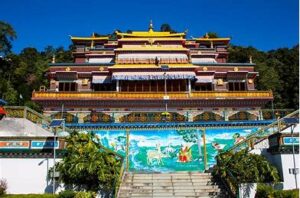Rinchengpong is a charming historical town, situated at an altitude of approximately 5576 ft in the West Sikkim region of India. This small town stands as a protector of ancient traditions and spellbinding narratives. of The locals living here, preserves a journey through time.
In the year 1860, the British forces looked to expand their eyes upon Sikkim. This clash left a deep mark on the region, altering its history forever. Yet, the locals ensured that the spirit of this land won’t die. They lived to build this town based on their culture and heritage. Other than this historical backdrop, many significant moments have occurred in this town. The Dak bungalow in Rinchengpong was the safe haven of Rabindranath Tagore as he wrote a piece of his magnum opus, “Geetanjali”.This peaceful land has been an inspiration to many. Covered with the mighty Kanchenjunga on one side, the population lives a slow life with warm smiles and a welcoming nature.
Colonial Past
The British colonial looked to replicate the success of Chinese tea cultivation in India. Rinchengpong, because of its natural resources became a part of the ambitious plan. They wanted to create a thriving tea industry in the Himalayan region.
Under the supervision of British planters, the plantation flourished in this area. The favorable conditions were beneficial for the planters. The region’s unique climate and altitude proved conducive to growing high-quality tea leaves. It gained international praise for its unique flavor and aroma.
During the colonial period, Rinchengpong saw many tea estates being established. This contributed to the economic prosperity of the British East India Company. The plantation became a hub of activity. Colonial-era bungalows, processing factories, and expansive tea gardens took over the location.
Post-independence, its tea plantations underwent significant changes in ownership and management. However, the legacy of British influence continues in the traditional methods of tea cultivation. The methods of processing continue to define the region’s tea industry.
Ancient trade routes
Rinchengpong used to be a crucial stop on the legendary Silk Route. The town saw merchants pass through its paths, exchanging not just goods but also cultures and customs. The ruins of historic trade posts still narrate an untold story. Once upon a time, the streets of Rinchengpong were bustling with caravans that once passed through, leaving behind an adventure.
Geography
Rinchengpong is situated in the eastern Himalayan range. The town is surrounded by greenery on one side and Kanchenjunga on the other. The elevated geographical location contributes to a moderate climate with cool temperatures, making the everyday life of the locals very pleasant.
Demography
The population of Rinchengpong is relatively small. It is primarily comprised of diverse ethnic groups. The demographic composition includes communities like Bhutias, Lepchas, and Nepalis, reflecting the multicultural nature of Sikkim as a whole.
Culture
Sikkim, including Rinchenpong, has a rich cultural heritage. Traditional dances, music, and festivals play a significant role in the lives of the people. The diverse communities have an accommodating cultural scene. Each tribe celebrated their various celebrations like Losar (New Year), Dashain, and Tihar.
Festivals
Several festivals are celebrated in this town. Losar is the celebration of the Tibetan New Year. Joyous dances and traditional music commemorate this festival.
Sikkim’s famous flower festival is also celebrated in this town along with other places like Gangtok. The various orchids and flowers are on display. Its fragrance is believed to have blessings. These festivals offer a glimpse into the vibrant spirit of the Sikkimese people.
Food
The intermix of tribes speaks for a unique culinary platter in this town. Aromatic Nepali momos are steamed to perfection. Other delicacies such as thukpas, provide a warmth and kick to the locals. This hot warm soup is an inspiration from Tibetan cuisine. Sweet steamed bread, called Tingmo is another dish famously consumed in this town.
Religion
The religious landscape in Rinchenpong is diverse, reflecting the coexistence of different faiths. Hinduism, Buddhism, and a blend of indigenous beliefs are prominent. There are temples, monasteries, and sacred sites that are integral to the spiritual life of the residents.
Rinchenpong’s spirituality is observed in the many magnificent monasteries that are built at hilly tops. These architectural marvels like Pemayangtse Monastery and Sanga Choling Monastery carry centuries of Buddhist traditions. Multicolor prayer flags flutter around in the wind. The chanting of monks and the intricate murals create an otherworldly atmosphere.
Occupation and Economy
Agriculture is a crucial occupation in Rinchenpong. They cultivate using the method of terrace farming. These types of fields support the cultivation of crops like rice, maize, and cardamom even in hilly areas.
Recently, tourism has also made its way into contributing to this town’s economy. The town attracts visitors who seek a quiet way of living amidst natural beauty.
Handicrafts, such as traditional weaving and woodwork also contribute to the local economy.
Way of Life
The way of life in Rinchenpong is influenced by the close-knit community sense. The natural beauty surrounding the fertile lands of this town offers a slow way of living, away from the hustle. This allows plenty of focus on traditional practices and customs. The older generation believes in upholding them and fostering a sense of identity among the locals. The pace of life is generally relaxed, with an emphasis on community bonds.
Education
While the town may not have numerous educational institutions, efforts are made to provide quality education. Students often travel to nearby towns or the capital, Gangtok, for higher education. The preservation of local culture is often incorporated into the curriculum.
Challenges
Rinchenpong, like many rural areas, faces challenges such as access to healthcare and educational facilities. Limited economic opportunities have led to the migration of the younger population to urban centers, impacting the demographic structure.
To protect this, Rinchenpong is now shifting towards balancing modernization with the preservation of cultural and environmental values which is essential for the town’s future.
In Conclusion
Rinchenpong in Sikkim is not just a geographical location but a whirlpool of diverse cultures and traditions. Understanding its demography, culture, religion, occupation, way of life, and challenges gives us a holistic outlook on the town’s dynamics. This hidden town is a cultural and historical haven.
Unravelling a billion untold stories, one chapter at a time, Humans of Northeast takes you on a discovery through vibrant Northeast India – a land rich in people, places, and culture. Ready to immerse yourself in more such stories? Visit our page HONEI to read more about narratives that inspire and uplift.




